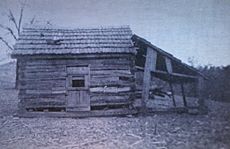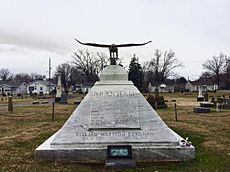William M. Branham facts for kids
Quick facts for kids William M. Branham |
|
 Branham in 1947 |
|
| Born | April 6, 1909 in Burkesville, Kentucky, U.S. |
|---|---|
| Died | December 24, 1965 (aged 56) in Amarillo, Texas, U.S. |
| Spouse |
|
| Children | 5 |
William Marrion Branham (April 6, 1909 – December 24, 1965) was an American Christian minister and faith healer. He was a central figure in the religious movement known as the healing revival, which took place after World War II. Many people believed he was a prophet sent to prepare the world for the Second Coming of Jesus Christ.
Branham's powerful preaching and claims of miracles made him very famous. His large meetings were some of the biggest religious gatherings of his time. He traveled all over the world, including North America, Europe, Africa, and India. His work had a big influence on televangelism and the modern charismatic movement. While many admired him, some of his later teachings were controversial and caused disagreements with other church leaders. Today, his followers, who call his teachings "The Message," can be found all around the globe.
Contents
A Humble Beginning
Childhood and Conversion
William M. Branham was born in a small log cabin near Burkesville, Kentucky, on April 6, 1909. He was the oldest of ten children born to Charles and Ella Harvey Branham, and his family grew up in deep poverty. He said his family sometimes did not have enough clothes.
Branham said that from a very young age, he had unusual experiences. He claimed that when he was a boy, a voice spoke to him from a tree, telling him about his future.
His family later moved to Jeffersonville, Indiana. When he was 19, he left home to find work in Phoenix, Arizona. He returned to Indiana after his brother passed away. Branham did not grow up in a religious family. The first time he ever heard a prayer was at his brother's funeral.
Soon after, Branham had a work accident that put him in the hospital. While recovering, he said he heard a voice that led him to start seeking God. He began attending a local church and became a Christian. A few months later, he was ordained as a minister.
Starting a Ministry
In June 1933, Branham held his first revival meetings in a tent. His followers believe that when he was baptizing people in the Ohio River, a mysterious bright light appeared above him. They also said a voice declared that his message would be a sign of the Second Coming of Christ. This story became very important to his followers.
By 1936, Branham and his congregation built a church in Jeffersonville called the Pentecostal Tabernacle, which later became known as the Branham Tabernacle. He served as the pastor there for many years.
In 1934, he married Amelia Hope Brumbach, and they had two children, Billy Paul and Sharon Rose. Sadly, a great tragedy struck his family. His wife and young daughter both became very ill and passed away in 1937. This was a very difficult time for Branham. A few years later, in 1941, he married Meda Marie Broy, and they had three children: Rebekah, Sarah, and Joseph.
The Healing Revival
Branham became one of the most famous leaders of the healing revival, a period in the 1940s and 1950s when many preachers held large public meetings focused on prayer for the sick. Many people saw him as the person who started this movement.
Rise to Fame
Branham said that on May 7, 1946, an angel visited him and gave him a mission to take a gift of healing to the world. After this, he began holding large campaigns across the country. News of amazing miracles at his meetings spread quickly, and huge crowds came to see him. His meetings were often the largest religious events some cities had ever seen.
His team included important figures like Gordon Lindsay, who helped manage his campaigns and publicize his work. In 1948, they started a magazine called Voice of Healing to share stories from the meetings. Another well-respected minister, F. F. Bosworth, also joined his team and supported his ministry for many years.
Style of Preaching
Unlike many loud and energetic preachers of his time, Branham was usually calm and spoke quietly. He often told stories from his own life to connect with the audience. During his meetings, people who wanted to be healed would line up in a "prayer line."
Branham was famous for what his followers called a "word of knowledge." He would often tell people in the prayer line specific details about their lives, such as their name, where they lived, or the sickness they had. This amazed the crowds and made many people believe he had a special gift from God.
International Campaigns
Branham's fame spread around the world. He held major campaigns in Europe, Africa, and India.
- Europe (1950): He preached to large crowds in Finland, Sweden, and Norway.
- South Africa (1952): His meetings here were some of the largest of his career, with one event drawing an estimated 200,000 people.
- India (1954): He continued his world tour with meetings in India, as well as Portugal and Italy.
During a meeting in Houston, Texas, in 1950, a photograph was taken that showed a bright light above his head. Branham and his followers believed this was a supernatural sign that proved his ministry was from God. The photo became very famous within the movement.
Challenges and Later Years

While many people admired Branham, his ministry also faced criticism and challenges. Not everyone was convinced that the healings were real.
Questions About Healings
From the beginning, some newspapers and other ministers questioned his work. Reporters would sometimes try to follow up with people who were said to be healed at his meetings. In some cases, they found that the person's condition had not actually improved.
Branham and his supporters believed that a person's faith was key to their healing. When a healing didn't last, it was sometimes blamed on the person's lack of faith. This caused disappointment for some who attended the meetings hoping for a miracle.
End of the Revival
By the mid-1950s, the healing revival began to fade. Many other preachers had started similar ministries, and the large crowds began to shrink. Organizing the campaigns was also very expensive, and Branham's team faced financial difficulties.
As the revival slowed down, Branham shifted his focus from healing services to a teaching ministry. He began to share more of his unique beliefs, which were often different from mainstream Christian doctrines. These teachings caused disagreements with the Pentecostal churches that had once supported him. However, he gained a group of very dedicated followers who believed his teachings were special revelations from God. They called his collection of sermons "The Message."
Death and Legacy
On December 18, 1965, Branham and his family were returning home for Christmas. They were about 3 miles (5 km) east of Friona, Texas. A car going the wrong way hit Branham's car head-on. He was taken to a hospital in Amarillo. He was in a coma for several days. He died from his injuries on Christmas Eve, December 24, 1965.
His death was a great shock to his followers. Some were so devoted that they hoped he would be resurrected. His funeral was held in December, but he was not buried until the following April, on Easter Monday.
William Branham left behind a complex legacy. He is remembered as a key leader who started the post-World War II healing revival. His ministry style and focus on spiritual gifts influenced the modern Charismatic movement and many televangelists.
While many mainstream churches rejected his later teachings, his message continues through his followers. Today, there are millions of people around the world who study his sermons and believe he was a prophet for our time.
Interesting facts about William M. Branham
- Branham encouraged a simple, strict way of life.
- He spoke out against television, rock and roll, and many kinds of worldly fun.
- Branham openly criticized other evangelists who seemed to get rich from their ministries. He was against messages that focused on wealth.
- He spoke against relationships between people of different races.
- Branham made several predictions during his life. These included the rise of Adolf Hitler, the Second World War, Italy taking over Ethiopia, and the rise of communism. Most of these predictions had already come true by the time he first shared them in 1953.
Images for kids
-
The House of David commune in Michigan, a group Branham visited in the 1930s.
See also
 In Spanish: William Marrion Branham para niños
In Spanish: William Marrion Branham para niños









